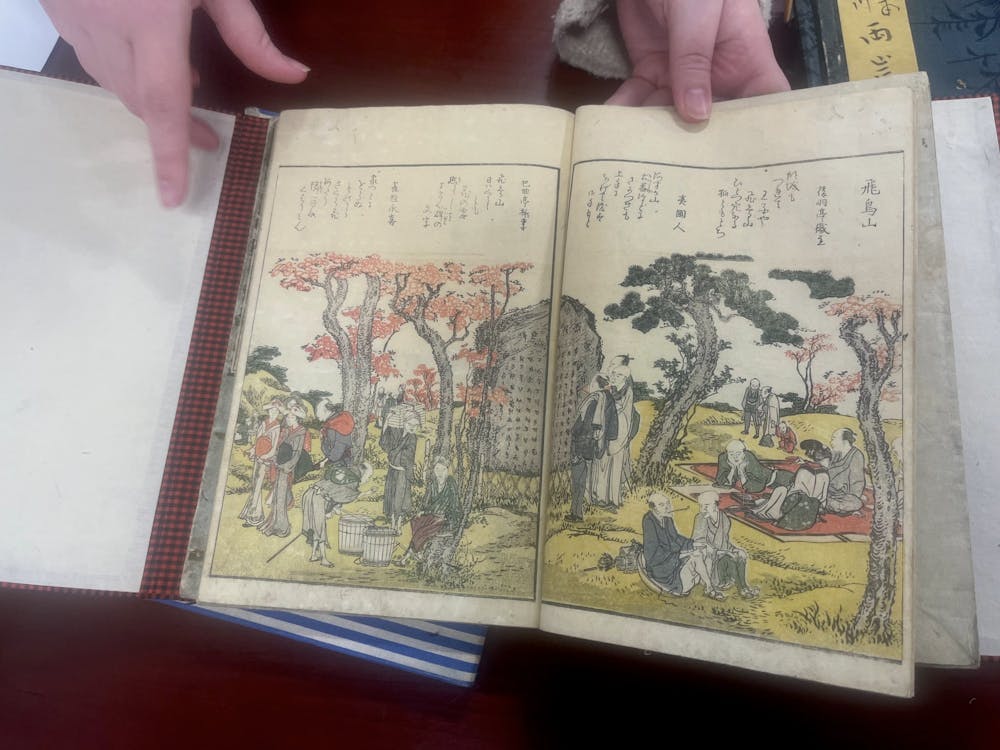The Great Wave off Kanagawa, a famous print by the Japanese artist Katsushika Hokusai, can often be found printed on graphic t-shirts and posters. This style of art, known as woodblock or ukiyo-e prints, is now featured in the American University Library archives, along with prints by Hokusai himself.
On the second floor of the Spring Valley Building students, faculty and staff can now flip through bound books and feel these historical prints that date back as early as the 17th century. Leslie Nellis, head archivist for special collections and digital initiatives at the Library, said that feeling the texture of the prints is a more personal experience compared to seeing them behind a glass case in a museum.
“We’re happy to have people look at [the prints] and be interested in them because they are such a treasure that we have,” Nellis said. “[We’re] hoping that people will continue to have interest in using them for scholarship, but also just to appreciate that they're beautiful.”
Although Nellis continues to purchase more prints to expand the collection, AU originally acquired the ukiyo-e prints through a donation from Charles Spinks. Spinks was a foreign service agent stationed in Japan in the 1930s when he began collecting ukiyo-e prints, before donating them to the University in the 1970s.
“He just really appreciated the art and built his personal library of these materials,” Nellis said. “Later in life, he was part of this government-sponsored research institute at AU. And I guess because of that relationship, he chose to donate his collection of over 1300 items to AU in the late 70s.”
Part of the fascination with these prints is the technique used to create them. Unlike traditional painting techniques, ukiyo-e prints are created in a multi-step process according to Hannah Karkari, an alumna of the art history masters program who worked at the archives during her time at the University.
The complicated process goes like this: first, the publishing house hires an artist like Hokusai to draw out the design for a print. The design is carved onto a woodblock, and then pressed into paper. Because the prints are produced this way, each individual color is a separate block.
“If you think of something like The Great Wave, that's an extremely complicated piece, and requires hundreds of blocks for every colorway inside that image,” Karkari said.
When Japan opened its borders during the Meiji Restoration, ukiyo-e prints poured into Europe through trade, according to Ken Knight, the director of the Japanese program in the department of world languages and cultures. Artists like Vincent van Gogh saw these prints and took inspiration to create world-famous paintings.
“It was all based on this interesting, interesting use of color that came from the block trance. So really unique,” Knight said. “Suddenly, you find something unique, and everybody copies it, and then the world changes.”
The prints became so popular that they are often seen as a definition of Japanese culture according to Ying-Chen Peng, an assistant professor of art history at AU. Often when we think of Mount Fuji we think of Hokusai’s print Thirty-six Views of Mount Fuji instead of an actual image of Mount Fuji.
“You also think of the big wave, right,” Peng said.
“And again, that's in the form of prints. So that tells you how ukiyo-e is really embedded in not only the making of modern, contemporary Japanese art, but also the perception is what we expect when we think of Japanese art.”
This article was edited by Sara Winick, Patricia McGee and Abigail Pritchard. Copy editing done by Isabelle Kravis.





